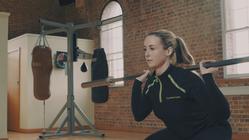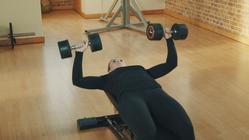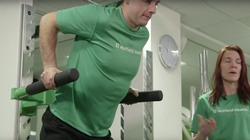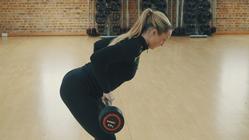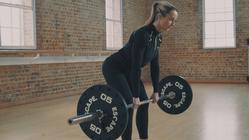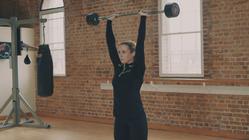What are supersets?
- Overview
The concept of a superset is to perform 2 exercises back to back, followed by a short rest (but not always). This effectively doubles the amount of work you are doing, whilst keeping the recovery periods the same as they are when you complete individual exercises.
Supersets are a great way to maximise your time in the gym. They can effectively double the amount of work you do during your workout, or you can complete your workout in half the time if you're a time-pressed individual.
What exercises should I do in a superset?
The two exercises used in a superset can be:
- Lower body exercises and upper body exercises
- Exercises that ‘oppose’ each other (i.e. pushing and pulling exercises) and therefore use opposing muscle groups (like the chest and the back)
- 2 exercises that focus on the same muscle group and use different ranges of movement to challenge the muscles in different ways
The exercises can be compound movements – exercises which move across multiple joints and therefore activate multiple muscle groups (like squats). They can also be isolation exercises, which focus on one particular muscle group (like bicep curls).
Pre- and Post-exhaust supersets
These types of superset pair together compound and isolation exercises that work similar muscles.
How do I perform a pre-exhaust superset?
To do a pre-exhaust superset, perform the isolation exercise first, followed by the compound exercise.
'Pre-exhaust' happens when a muscle first works in isolation, then continues working as part of a larger group of muscles in a compound exercise.
Example of a pre-exhaust superset:
- Barbell bicep curl x 8 reps
- 0 -15 seconds rest
- Seated row x 8 reps
This pre-exhaust superset places emphasis on the biceps.
How do I perform a post-exhaust superset?
To do a post-exhaust superset, perform the compound exercise first, followed by the isolation exercise.
'Post-exhaust' happens when you fatigue the muscle you want to focus on during the larger compound movement, then focus in on that particular muscle group in the isolation exercise
Example of a post-exhaust superset:
- Barbell bench press x 8 reps
- 0 -15 seconds rest
- Dumbbell chest flyes x 8 reps
This post-exhaust superset places emphasis on the chest.
Which is better? Pre-exhaust or post-exhaust supersets?
Arguably, you get a greater benefit from post-exhaust work as opposed to pre-exhaust.
This is because your compound exercises recruit multiple muscles and are usually big exercises that require good technique and coordination. So it’s better to complete this larger, more complex exercise first, then move on to the smaller isolation exercise to focus on a muscle that has been worked in the larger movement.
And since compound exercises offer the most ‘bang for your buck’ in terms of adaption and progression in the gym, it might be more beneficial to prioritise them and complete them first.
That said, supersets are a flexible training method. Whether you choose pre- or post-exhaust exercises – or any of the many other forms of superset, you can structure them for your specific goals to get the most out of them.
Are supersets good for building muscle?
The simple answer is yes. Any resistance exercise (especially if you are new to resistance training) will help build muscle. If building muscle (hypertrophy) is your goal, then you can use supersets effectively to achieve this.
How many reps in a superset?
The number of reps per superset depends on your goals.
Superset reps for building muscle
If your goal is to increase muscle mass (hypertrophy), then aim for 8-12 reps of each exercise (16-24 total reps of two back-to-back exercises).
Let’s take two exercises you could do in a superset; the bench press and the lat pulldown. If you’d perform a similar number of reps for each exercise individually, why not put them together? They’re different exercises, and they work different muscle groups. So if you want to truly maximise your time in the gym, you should pair the two together.
Example of a muscle-building superset:
- Bench press x 8 reps
- No rest
- Lat pulldown x 8 reps
- 90 seconds rest
- Repeat the superset 2 more times.
You’ve just done the same two exercises, but you’ve worked harder than you would have if they were done individually, and saved yourself some time too.
Superset reps for getting stronger
If your goal is to increase strength, then you may want to consider reducing the number of reps to 4-6 and aim to increase the resistance (amount of weight) you’re using.
Bear in mind that performing supersets for strength requires maximum effort and is really only recommended for advanced trainees. Many people will need a sufficient rest period in between sets of heavy lifting.
If you're going to perform supersets for strength, you'll need to lift less weight than you would normally lift for an individual strength-based exercise with a rest period.
Example of a strength-building superset:
- Barbell squat x 4-6 reps
- 15 seconds rest
- Barbell bent over row x 4-6 reps
- 2 minutes rest
- Repeat the superset 2 more times.
Before attempting this, make sure you're comfortable performing the exercises with good form and range of movement.
Progressive overload – increasing resistance or reps
Progressive overload is the process of gradually increasing the difficulty of an exercise once you feel it’s not challenging enough. When you’re setting fitness goals, progressive overload is a key principle used to make small, manageable changes over time.
For example: if you’re currently completing supersets doing 8 reps of each exercise, once you feel like this is becoming more manageable and you feel you are able to complete the exercises well (i.e. with good technique, range of movement etc.) then you can look to increase either the number of reps in each set (e.g. from 8 to 10) or the weight you're lifting.
Alternatively, you could stick with 8 reps and increase the resistance you are using a small amount (i.e. add 2.5kg to your bench press). It might be a good idea for you to go through a process of trial and error to find out what works best for you.
Don’t forget you can always seek the advice of a personal trainer to help you select exercises that are appropriate for you.
Are supersets good for fat loss?
When we complete supersets, the amount of rest we have relative to the amount of work we are doing is small, which means the cardiovascular system (heart) is working extra hard throughout. This high metabolic demand is great for burning calories and therefore fat loss.
Supersets are a great way to bring cardiovascular work into your resistance training – a good ‘all round’ training method.
This is because, whilst muscles that have worked in the first exercise are recovering, the muscles used in the second exercise are working (and vice versa). Whilst muscles are recovering, the cardiovascular system is still working to power the other muscle groups that are working in the other exercise. This results in a high heart rate (and therefore calorie expenditure) for the duration.
Take a lower body/upper body superset as an example:
If you perform a set of squats, then immediately move on to dumbbell chest press, the legs are working hard in the squat, and the cardiovascular system sends blood carrying energy, oxygen and everything the legs need to do squats down to the leg muscles. Then suddenly, you stop squatting and almost immediately ask the body to start completing a chest press.
The cardiovascular system now has to send everything it has just sent to the legs, up to the upper body to complete the chest press. This is called a ‘cardiovascular shunt’ and (as the name would suggest), it is when the cardiovascular system has to redistribute blood containing everything that is necessary for exercise and effective muscle contractions from one part of the body to another.
This is what makes supersets working different muscle groups great for building muscle, burning calories and improving heart function.
Don't overlook your diet
Always remember that ultimately, fat loss starts in the kitchen! Unfortunately, no amount of supersets can offset a bad diet and lifestyle. For some guidance on how you can improve your diet, take a look at our nutrition articles
Examples of exercises to use in supersets
Consider these exercise pairings for an effective superset.
- Bench press and bent over row (working chest and back)
- Leg extension and leg curl (working quadriceps and hamstrings)
- Wide grip pulldowns and close grip seated row (both back exercises with varying ranges of movement)
- Hammer curls and cable tricep extensions (biceps and triceps)
- Leg press & leg extension (post-exhaust focusing on the quadriceps)
Full body superset workout
A full body superset workout; focusing on larger compound movements, and focusing on a lower body/upper body set up could look something like this:
- Superset 1. Back squats and dumbbell chest press
- Superset 2. Lunges and bent over row
- Superset 3. Romanian deadlifts and military press
- Superset 4. Leg press and tricep dips
This is a highly effective but challenging superset workout. So make sure you're comfortable performing each exercise and adjust the weight depending on how difficult you find each set as you go through the workout. The key is to keep the rest periods short so that your heart works harder.
Scroll through our video gallery to view tutorials on some of these superset exercises.
Key takeaway
Supersets have many benefits and the variations to choose from mean that anyone can incorporate supersets into their training.
They’re great for doing more work in less time, combine cardiovascular and resistance work and can be a great option if you’re reaching a plateau or just want to try something different to traditional individual exercise-based workouts.
Last updated Wednesday 31 August 2022
First published on Thursday 7 January 2016


